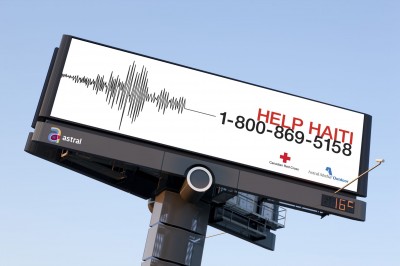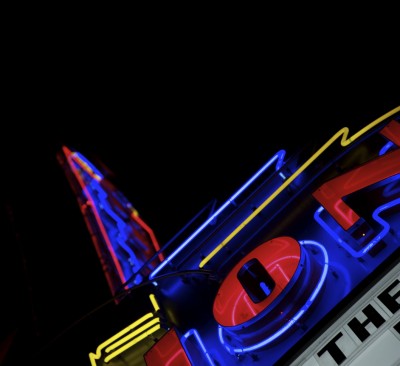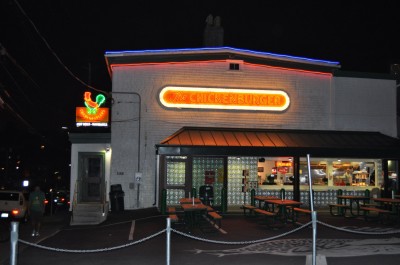Illumination: Shedding light on sign issues
by all | 27 September 2013 8:30 am
 [1]
[1]Photo courtesy Pattison Outdoor
By David Hickey
The sign industry and its commercial customers face a growing number of illumination restrictions today, with local officials in Canada and around the world issuing proposals to make signs less bright and more energy-efficient. It is important for the sign industry as a whole to be proactive in developing standard brightness recommendations, particularly for electronic message centres (EMCs).
To help educate officials about these issues, while also protecting sign companies, the International Sign Association (ISA) has, for its part, worked with the Sign Association of Canada (SAC), established recommendations for nighttime EMC brightness, developed industry positions on regulatory issues for internally illuminated signs and shutoff requirements, testified on sign lighting issues for bodies developing new codes—such as the International Green Construction Code (IGCC)—and formed a sign illumination subcommittee.
The regulatory threat
Regulatory initiatives that aim to restrict or control artificial nighttime lighting—such as Toronto’s current Municipal Code, which does not allow commercial signs to be illuminated between 11 p.m. and 7 a.m. unless (a) they represent businesses operating during those hours or (b) they are in ‘special sign districts’—are on the increase at multiple levels of government. Advocacy and lobbying efforts by ‘Dark Skies’ groups have resonated with various regulatory bodies, principally because these groups have sought to link energy conservation with their proposals to mandate the dimming of electric signs.
In the U.S., the American Society of Heating, Refrigeration and Air Conditioning Engineers (ASHRAE) has incorporated requirements for substantial power reductions for electric signs—specifically, those operated at night by businesses that are closed during those hours—into its energy-efficiency standards for new and substantially renovated commercial buildings. ISA was recently successful in convincing ASHRAE to remove these requirements for electric signs, but nevertheless, it is widely anticipated ASHRAE may adopt a requirement in the future for substantial electrical load reductions for signs.
 [2]
[2]With the proliferation of digital billboards in recent years, some local authorities have moved to regulate sign brightness through new standards. Photo courtesy Astral Out-of-Home
Such issues are not simply theoretical for the Canadian sign industry. In fact, the Canadian Standards Association’s (CSA’s) technical committee for the performance of lighting equipment recently established a subcommittee with the objective of developing a new standard for the performance levels of stationary backlit electric signs.
CSA’s subcommittee reports it is pursuing the new standard to reap “significant energy savings from an increase in energy efficiency of hard-wired luminous signs available on the market and the phase-out from the market of signs that do not meet consensus-based performance levels.” Unfortunately, CSA’s process has shown some significant flaws from the start, including the claim that “outdoor signage represents 20 per cent of total outdoor lighting” (a wild overestimation) and the citing of a Dark Skies model outdoor lighting ordinance as a research source. ISA is working with SAC to represent the on-premise sign industry’s interests as CSA moves forward with its process.
A glaring need to respond
Given such trends, it is obvious these regulatory efforts to limit permissible sign brightness levels point to a glaring need for the sign industry to develop a comprehensive response to preserve the utility and visual impact of commercial signage. In an era of rapid technological change, this issue represents a key priority for both the sign industry at large and its entire community of commercial customers.
In April, ISA participated in the Lightfair International (LFI) Conference and Expo, the world’s largest annual architectural and commercial lighting trade show. The association’s goal was to continue to gather information and find new opportunities to help protect the ability of its members to thrive in the business of manufacturing and selling illuminated signs.
 [3]
[3]‘Dark Skies’ groups, especially, have lobbied for regulatory initiatives to restrict or control sign lighting at night. Photos courtesy ISA
This involved meeting with a variety of stakeholders in the industry, several of whom are ISA members themselves, and learning from lighting experts. From these discussions, it is apparent that as regulatory authorities and code-developing bodies intend to move forward with plans to mandate higher efficiency targets, lighting and signs are getting swept up in these efforts. More still needs to be done.
Defending signs
The proliferation of EMCs and digital billboards in recent years appears to represent one of the factors contributing to the general perception by local authorities that sign brightness needs to be regulated and controlled through lighting standards. And when these new standards are combined with broad efforts to substantially increase the energy efficiency of all types of electrical devices, it is inevitable traditional electric signs will come under scrutiny by government officials.
The sign industry must be prepared to meet this challenge, justifiably defending its products on the grounds they promote economic activity, enhance public safety and represent both a historic and a continuously innovative form of communication. With these benefits in mind, ISA has welcomed the opportunity to defend the notion that electric signs should continue to be effectively visible at night.
After all, the intrinsic value of an electric sign is closely linked to its ability to be readily detected and read in a variety of nighttime outdoor environments. Brightness or luminance is one of the key factors in determining how readily an electric sign is detected after dark. The faithful representation of company logos and corporate trademarks has a significant impact on the colour schemes displayed on translucent sign faces and the corresponding amounts of light emitted by those signs. Electric signs also are affected by other light-limiting factors that result from aging lamps and exposure to weather.
 [4]
[4]Electric signs are affected by light-limiting factors that result from aging lamps and exposure to weather.
In the past, the sign industry incorporated standardized types and configurations of fluorescent and neon light sources for the internal illumination of plastic-faced signs. These conventional light sources and standardized lamp or tube configurations were used successfully over several decades and their suitability for a broad range of locations and environmental conditions was well-established.
Wielding influence
Government officials, regulatory agencies and standards organizations around the world have worked to impose limits on sign illumination, but their efforts have often been arbitrary, without being based on objective evidence. Further, by not involving the counsel of the sign industry, there is a sizeable void in knowledge among key decision-makers. In many cases, authorities with jurisdiction over the historical and modern development of sign illumination lack pertinent information about that development.
This is why a significant opportunity now exists for the sign industry to influence the development of new regulations that will affect electric signs. With ISA’s ongoing technical research and SAC’s assistance in advocacy efforts, the industry can work to preserve the value of its products and, in so doing, promote a favourable business environment for the continued development, use and value of signs.
David Hickey is vice-president (VP) of government relations for ISA. For more information, visit www.signs.org[5].
- [Image]: http://www.signmedia.ca/wp-content/uploads/2014/01/PattisonOutdoor.jpg
- [Image]: http://www.signmedia.ca/wp-content/uploads/2014/01/Digital_Haiti_ENG-copy.jpg
- [Image]: http://www.signmedia.ca/wp-content/uploads/2014/01/neon-marquee.jpg
- [Image]: http://www.signmedia.ca/wp-content/uploads/2014/01/RestaurantInHalifax.jpg
- www.signs.org: http://www.signs.org
Source URL: https://www.signmedia.ca/shedding-light-on-sign-issues/